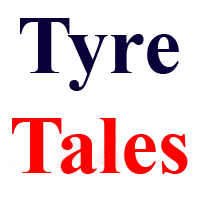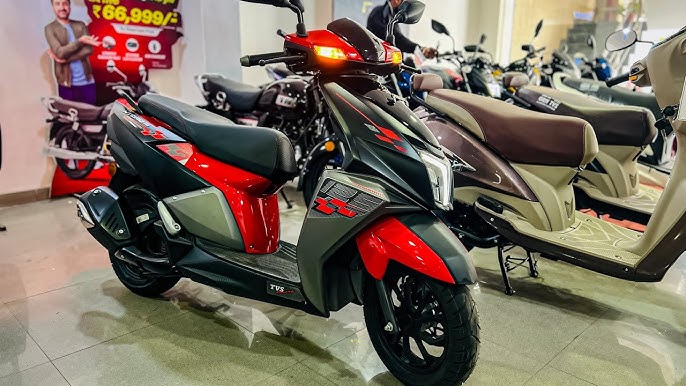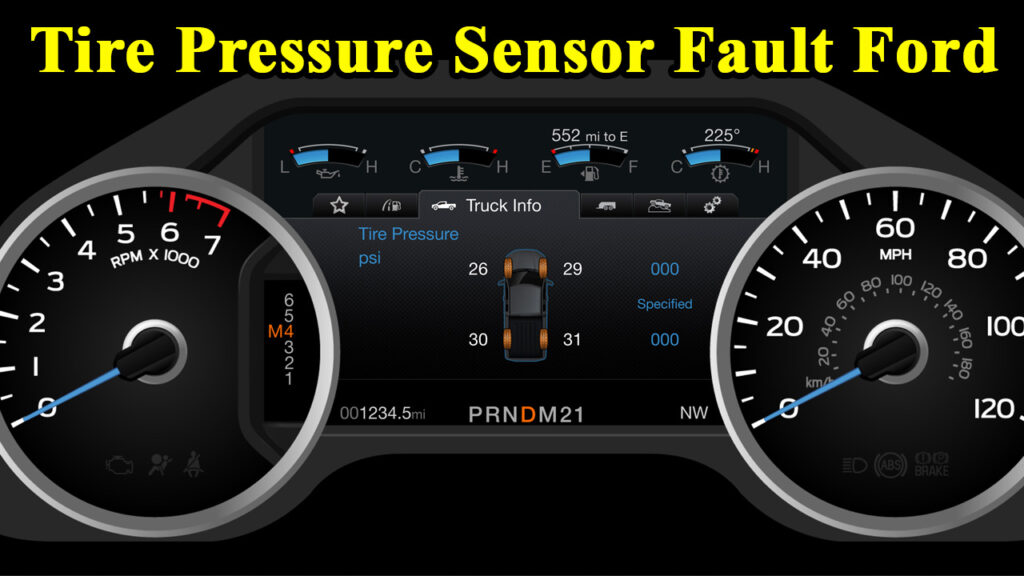When you first rode your gleaming new TVS NTorq off the showroom floor, it came fitted with a specific set of tyres – known as Original Equipment Manufacturer (OEM) tyres. For the TVS NTorq, the standard fitment is typically from TVS Eurogrip. These are usually the TVS Eurogrip ATT 455 Remora or similar patterns.
Let’s break down the stock specifications:
- Front Tyre: 100/80-12 (Tubeless)
- Rear Tyre: 110/80-12 (Tubeless)
What do these numbers mean?
- 100/80-12 (Front):
- 100: This is the width of the tyre in millimeters (100mm).
- 80: This is the aspect ratio, meaning the tyre’s sidewall height is 80% of its width. So, 80% of 100mm.
- 12: This indicates the diameter of the wheel rim in inches (12 inches).
- 110/80-12 (Rear): The rear tyre is slightly wider (110mm) to handle the scooter’s power and provide better traction, especially during acceleration. The aspect ratio and rim diameter remain the same.
Pros of Stock Tyres: TVS Eurogrip, being the OEM supplier, designs these tyres to perfectly complement the NTorq’s chassis, suspension, and engine characteristics. They offer a balanced performance for most general riding conditions in India – a decent blend of grip, longevity, and comfort for city commutes and occasional highway runs. They are designed to be reliable all-rounders.
Cons of Stock Tyres: While capable, OEM tyres are often a compromise. They might not excel in very specific conditions. For instance, if you frequently ride on extremely wet roads during the monsoon or crave a sportier, more aggressive cornering feel, the stock tyres might leave you wanting more.
How Much Does Walmart Charge For Tire Installation
Why Tyres Matter: Beyond Just Rolling
It’s easy to dismiss tyres as just “rubber.” But they are, in fact, an engineering marvel, playing a multifaceted role in your riding experience:
-
Safety First: This is non-negotiable. Your tyres are the only point of contact between your 110+ kg NTorq (plus rider and pillion) and the road.
- Braking Distance: Good tyres, with ample tread and appropriate compound, significantly reduce braking distances, especially in emergency situations. Imagine riding through heavy traffic in Delhi; every metre counts.
- Grip in Wet/Dry Conditions: A tyre’s tread pattern is crucial for dispersing water on wet roads, preventing aquaplaning. On dry roads, the rubber compound and contact patch determine how well your scooter sticks to the tarmac, particularly during aggressive turns.
- Cornering Stability: The profile and stiffness of a tyre influence how confidently your NTorq leans into turns. A stable tyre ensures predictable handling, a joy for navigating winding roads like those leading up to Nandi Hills.
-
Performance Unleashed: Tyres directly impact how your NTorq feels and responds.
- Acceleration: Proper grip is essential for efficient power transfer from the engine to the road, meaning snappier acceleration off the line.
- Handling: The right tyres can make your NTorq feel more nimble, responsive, and easier to manoeuvre through tight spots.
- Fuel Efficiency: While less significant than engine tuning, correctly inflated and well-designed tyres can contribute marginally to better fuel economy by reducing rolling resistance.
-
Comfort on the Go: Tyres absorb a significant amount of road imperfections. A good set of tyres can make your ride noticeably smoother, soaking up the bumps and undulations that are all too common on Indian roads, from the cobbled lanes of Old Ahmedabad to the broken patches in rural Kerala.
-
Longevity & Scooter Health: Well-maintained, quality tyres last longer, saving you money in the long run. They also contribute to the overall health of your scooter by reducing undue stress on suspension components and the chassis.
Decoding Tyre Specifications: What Do Those Numbers Mean?
Beyond the size, there’s a world of alphanumeric codes on your tyre’s sidewall. Let’s demystify them:
- Speed Rating (e.g., ‘P’, ‘Q’, ‘R’): This letter indicates the maximum speed the tyre can safely maintain. For scooters like the NTorq, ratings typically range from P to R.
- P: 150 km/h
- Q: 160 km/h
- R: 170 km/h Always choose a tyre with a speed rating equal to or higher than your scooter’s top speed.
- Load Index (e.g., ’56L’, ’61L’): The number (e.g., 56, 61) corresponds to the maximum weight the tyre can carry. The letter (e.g., L) is the speed rating as above. Again, match or exceed the OEM specification to ensure safe carrying capacity for yourself, a pillion, and any luggage.
- Tread Pattern: This is the design on the tyre surface.
- Symmetrical: Same pattern on both sides, good for general use.
- Directional: Designed to rotate in one direction, excellent for water dispersion and high-speed stability. Look for an arrow on the sidewall.
- Asymmetrical: Different patterns on inner and outer edges, offering a balance of wet and dry grip. For scooters, directional and symmetrical patterns are most common. A pattern with deep, well-spaced grooves is generally better for wet grip, a crucial factor during the Indian monsoon season.
- Construction: Tubeless Tyres: The TVS NTorq comes with tubeless tyres, which are the industry standard for modern two-wheelers.
- Advantage: In case of a puncture, air leaks out slowly, giving you time to reach a tyre shop. Unlike tube tyres, they don’t deflate instantly, greatly enhancing safety. Puncture repair is also generally easier and quicker.
Upgrading Your TVS NTorq Tyres: A World of Options
So, you’ve clocked a good number of kilometres, and your stock tyres are showing wear, or perhaps you’re simply looking to enhance your riding experience. This is where the aftermarket tyre market comes into play, offering a plethora of choices to suit different needs and riding styles.
When to Consider an Upgrade:
- Worn-out Stock Tyres: The most obvious reason. Never compromise on safety with bald tyres.
- Specific Riding Needs:
- Enhanced Wet Grip: If you frequently ride in heavy rain (like during Mumbai’s monsoon), a tyre specifically designed for superior wet traction will be a game-changer.
- Sportier Handling: For those who enjoy spirited riding and aggressive cornering, a tyre with a softer compound and sportier profile can significantly improve confidence and lean angles.
- Increased Longevity: If your commute is extensive and you prioritize mileage, some tyres are engineered for longer life.
- Improved Comfort: Some tyre compounds and constructions offer better bump absorption.
How Much Is A Tire Rotation At Jiffy Lube
Popular Aftermarket Brands in India (and what they offer):
Here’s a look at some trusted brands available across India, from your local tyre shop in Chennai to online retailers:
- CEAT: A strong Indian brand, CEAT offers reliable and value-for-money options.
- Popular for NTorq: CEAT Zoom X3 (Scooter).
- Insight: Many riders swear by the Zoom X3 for its balanced performance, offering good grip and stability for daily commutes. My colleague, who owns an NTorq, switched to a CEAT Zoom X3 rear tyre after his stock one wore out. He immediately noticed a smoother ride and better confidence during quick lane changes in Pune’s traffic.
- Value: Generally competitive, with prices for NTorq sizes ranging from ₹2,000 – ₹2,400 per tyre.
- MRF: Another homegrown giant, MRF tyres are known for their durability and robust construction, often preferred for their ability to withstand challenging Indian road conditions.
- Popular for NTorq: MRF Zapper N.
- Insight: MRF Zapper series tyres are a popular choice for their longevity and reliable performance. They offer good all-round grip and are a solid replacement for stock tyres. I know a delivery rider in Kolkata who relies on MRF tyres for their sheer endurance on continuous, long rides.
- Value: Similar to CEAT, expect prices around ₹1,800 – ₹2,300.
- Michelin: A global leader, Michelin is synonymous with premium quality, offering superior grip and handling, albeit at a higher price point.
- Popular for NTorq: Michelin City Extra.
- Insight: The City Extra is highly recommended for its exceptional wet and dry grip and comfortable ride. While some EV scooter owners have noted a potential impact on range (due to a softer compound, perhaps), for the NTorq, it provides a noticeable upgrade in safety and handling. If you prioritize absolute grip and don’t mind spending a bit more, Michelin is a fantastic choice.
- Value: These are at the higher end, typically ranging from ₹2,400 – ₹3,000+ per tyre. The extra investment, however, translates to enhanced safety and a superior riding feel.
- TVS Eurogrip: Beyond OEM, TVS Eurogrip also offers aftermarket options with improved compounds or tread patterns.
- Popular for NTorq: Continue with updated versions of ATT 455 Remora or explore other specific scooter patterns they offer.
- Insight: They understand the Indian market and local road conditions well. Their newer compounds often aim to provide a good balance of grip and longevity.
- Value: Generally in the ₹1,900 – ₹2,500 range.
- Apollo: A strong contender in the Indian tyre market, Apollo offers a range of scooter tyres.
- Popular for NTorq: Actizip S2, Actigrip S3/S4.
- Insight: Apollo tyres are known for offering decent performance and durability at a competitive price, making them a good mid-range option.
- Value: Prices typically range from ₹1,300 – ₹2,200.
- Reise: A relatively newer player, Reise has quickly gained traction for its diverse range, including options that lean towards performance.
- Popular for NTorq: twistR, torqR, tripR.
- Insight: Some of their offerings like the torqR are positioned as premium options. They are worth exploring if you’re looking for something beyond the traditional choices.
- Value: Prices can vary significantly, from economical options around ₹1,400 to premium ones exceeding ₹4,000.
Choosing Your Upgrade – The Value Proposition: When considering an upgrade, think of it as an investment in your safety and riding pleasure. While a basic replacement might cost ₹1,700, investing in a premium tyre for ₹2,800 or more offers better safety, longevity, and a significantly improved riding experience. The cost difference is minimal when you consider the benefits over the tyre’s lifespan. Remember, a cheap tyre might save you a few hundred rupees upfront, but could cost you much more in terms of safety or frequent replacements.
Tyre Maintenance: Extending Life and Ensuring Safety
Even the best tyres won’t perform optimally without proper care. Regular maintenance is key to extending their lifespan and, most importantly, ensuring your safety on the road.
- Tyre Pressure: The Golden Rule: This is arguably the most critical aspect of tyre maintenance.
- Why it matters:
- Safety: Incorrect pressure (either too high or too low) severely impacts grip, stability, and braking. Under-inflated tyres can lead to overheating and a higher risk of blowouts, a terrifying thought on a busy highway. Over-inflated tyres reduce the contact patch, leading to poor grip and a harsher ride.
- Performance: Proper pressure ensures optimal handling, acceleration, and cornering.
- Fuel Efficiency: Under-inflated tyres increase rolling resistance, leading to reduced fuel economy.
- Tyre Life: Correct pressure promotes even tread wear, maximizing the tyre’s lifespan.
- How to check: Refer to your NTorq’s owner’s manual or the sticker near the footboard/chain guard for recommended tyre pressures (usually in PSI). Check pressure when tyres are cold, ideally once a week or before a long ride. My local mechanic in JP Nagar, Bengaluru, always reminds me, “Sir, હવા ಚೆಕ್ ಮಾಡೋದು ಮರೀಬೇಡಿ” (Don’t forget to check the air).
- Why it matters:
- Tread Wear Indicators (TWIs): These are small bars moulded into the tread grooves. When the tyre tread wears down to these bars, it’s time for a replacement. They serve as a visual warning. Don’t wait until your tyres are bald – it’s incredibly dangerous, especially on wet Indian roads.
- Rotation (less common for scooters): While cars often benefit from tyre rotation, it’s less critical for scooters due to their different wear patterns. However, if you notice uneven wear, discuss it with a tyre expert.
- Cleaning: Regularly clean your tyres to remove dirt, grime, and road tar. Avoid harsh chemical cleaners as they can degrade the rubber compound. A simple soap and water solution is usually sufficient.
- Alignment & Balancing (occasional check): If you experience vibrations at speed or the scooter pulls to one side, it might be an issue with wheel alignment or balancing. While less frequent for scooters, it’s worth checking, especially after hitting a major pothole or if you’ve changed the tyre.
The Human Element: Beyond the Technical Specs
I’ve seen countless riders, including myself in my early riding days, treat tyres as an afterthought. We focus on the engine’s cubic capacity or the scooter’s top speed, forgetting that all that power is useless without a reliable connection to the road.
Choosing the right tyre isn’t just about matching numbers; it’s a deeply personal decision influenced by your riding style, budget, and the specific conditions you encounter daily. Do you spend most of your time crawling through city traffic, or do you occasionally venture out on longer rides? Is your city notorious for sudden downpours, or are the roads generally dry?
My experience with that monsoon skid truly highlighted the peace of mind that comes with knowing your tyres are up to the task. It’s a feeling of confidence when you brake suddenly, knowing your NTorq will respond predictably. It’s the assurance when you lean into a corner, feeling the grip rather than a hint of slip. This peace of mind, for me, is invaluable.
Important Values and Originality
The overarching values I want to emphasize are safety, informed choice, and value for money.
- Safety First: This cannot be stressed enough. Tyres are the most critical safety component on your scooter. Investing in good quality tyres and maintaining them properly is a direct investment in your life and the lives of those around you.
- Informed Choice: My aim here is to empower you, the NTorq owner, with the knowledge to walk into a tyre shop and have a meaningful conversation, rather than just blindly accepting whatever is offered. Understanding the specs and brands helps you make a decision that genuinely suits your needs.
- Value for Money: This isn’t about buying the cheapest tyre. It’s about understanding that a slightly higher upfront cost for a quality tyre can lead to significant long-term savings through better safety, longer life, and a more enjoyable riding experience. The “value” extends far beyond the price tag.
Conclusion: Your NTorq’s Foundation for a Great Ride
Your TVS NTorq is a fantastic scooter, a true performance leader in its segment. But its full potential – and your safety – can only be realized with the right tyres. They are the unsung heroes, silently working to keep you connected to the asphalt, whether you’re commuting to work in Delhi, exploring the scenic routes of Goa, or simply enjoying a leisurely ride around your neighbourhood.
Don’t treat your tyres as an afterthought. Understand their specifications, consider your riding needs, explore the excellent aftermarket options available in India, and commit to regular maintenance. By doing so, you’re not just buying new rubber; you’re investing in a safer, more comfortable, and truly exhilarating riding experience on your TVS NTorq. Ride smart, ride safe!
Frequently Asked Questions (FAQ)
Q1: How often should I change my TVS NTorq tyres? A1: There’s no fixed mileage, as it depends on riding style, road conditions, and tyre quality. However, a good rule of thumb is every 20,000-25,000 km for the rear tyre and 30,000-35,000 km for the front. Always check the tread wear indicators (TWIs) and look for cracks or bulges. If the tread is shallow or the rubber looks old and brittle, it’s time for a change regardless of mileage.
Q2: Can I use a different size tyre on my NTorq? A2: It’s generally recommended to stick to the OEM specified sizes (Front: 100/80-12, Rear: 110/80-12). While some riders opt for slightly wider tyres for a sportier look or perceived grip, this can negatively impact handling, cornering, and even fuel efficiency. Always consult with a trusted tyre expert if considering a size change.
Q3: What’s the best tyre pressure for my TVS NTorq? A3: Always refer to the recommended tyre pressure sticker on your scooter (usually near the footboard or swingarm) or your owner’s manual. Typically, it’s around 22-24 PSI for the front and 29-32 PSI for the rear when riding solo, with slightly higher pressure for a pillion. Check pressure when the tyres are cold.
Q4: Are tubeless tyres better than tube tyres for the NTorq? A4: Yes, absolutely. The TVS NTorq comes standard with tubeless tyres, which are superior. In case of a puncture, tubeless tyres deflate slowly, allowing you to safely reach a repair shop. Tube tyres, on the other hand, can deflate rapidly, posing a significant safety risk, especially at higher speeds.
Q5: Where can I buy genuine TVS NTorq tyres or reliable aftermarket options in India? A5: You can purchase tyres from authorized TVS service centers, leading tyre dealerships (like those specializing in CEAT, MRF, Michelin, Apollo), or reputable online tyre retailers. Ensure you buy from a trusted source to get genuine products with proper warranties. It’s always a good idea to check for the manufacturing date (DOT code) on the tyre to ensure it’s not old stock.


